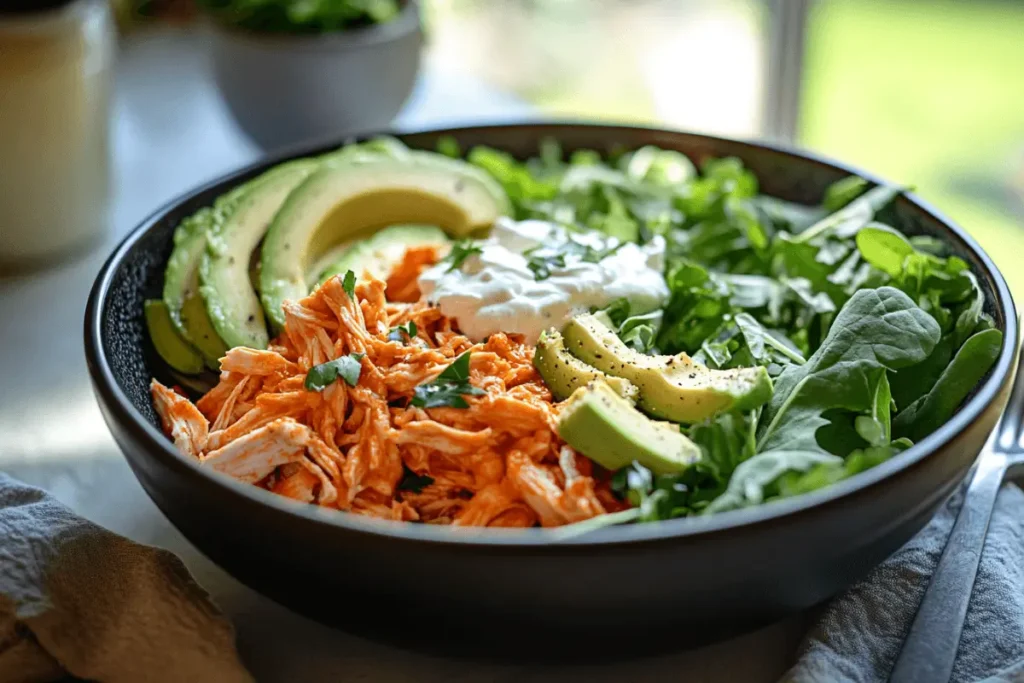Buffalo chicken has gained immense popularity, not just for its tangy kick but also as a protein-packed favorite. From crispy wings dipped in creamy ranch to shredded buffalo chicken topping hearty salads and wraps, this dish is a staple on menus and at dinner tables everywhere. Its bold flavor and versatility make it a crowd-pleaser, whether you’re hosting a game-day party or preparing a quick meal at home.
But beyond its mouthwatering taste, buffalo chicken sparks an important question: Is buffalo chicken a good source of protein? As health-conscious eating continues to gain momentum, understanding the true nutritional value of our favorite dishes becomes crucial. While buffalo chicken is often enjoyed as a high-protein option, the way it’s prepared—fried, baked, or grilled—can significantly impact its healthiness.
In this article, we’ll dive deep into the nutritional profile of buffalo chicken, compare it with other popular protein sources, and examine how it stacks up in terms of health benefits. Additionally, we’ll Innovate potential drawbacks, such as high sodium content, and share tips for preparing buffalo chicken in ways that maximize its nutritional value. By the end, you’ll know whether this spicy favorite is a solid choice for your diet and how to make it even healthier without sacrificing flavor.
Table of contents
Understanding Buffalo Chicken as a Protein Source

What Is Buffalo Chicken?
Buffalo chicken, a household name among spicy food lovers, typically refers to chicken prepared with buffalo sauce—a zesty blend of hot sauce, butter, and seasonings. Whether served as crispy fried wings, baked tenders, or shredded in salads, it’s a fan favorite at gatherings, especially during game days.
However, the nutritional profile of buffalo chicken can vary greatly depending on preparation methods. Traditional deep-fried buffalo chicken wings are calorie-dense due to added fats, while grilled or baked versions retain a leaner nutritional edge.
Nutritional Basics of Buffalo Chicken
When it comes to protein, buffalo chicken doesn’t disappoint. A standard serving of chicken breast, a common base for buffalo chicken dishes, provides approximately 25–30 grams of lean protein per 3-ounce portion. This makes it an excellent option for muscle building and tissue repair.
- Frying: Adds unhealthy fats, diminishing its appeal as a health-conscious choice.
- Grilling or Baking: Retains the natural high-protein content while cutting down unnecessary calories.
- Using Skinless Chicken: Keeps saturated fat in check, making it suitable for weight management.
Buffalo chicken’s appeal isn’t just in its bold flavor. It’s a versatile way to enjoy chicken—a meat that ranks high on the list of healthy protein sources. Still, keep an eye on sodium levels from buffalo sauce to include your meal stays balanced.
Comparing Buffalo Chicken to Other Protein Sources
Chicken vs. Buffalo Meat
When it comes to protein, chicken and buffalo meat are often compared for their nutritional perks. While buffalo meat (also known as bison) is celebrated for its lean, high-protein content, buffalo chicken takes a different path. The key difference lies in preparation. Buffalo meat, in its natural form, delivers more protein per serving than chicken. However, buffalo chicken dishes, especially those using lean cuts like chicken breast, can still compete as a solid protein source.
For example, a 3-ounce serving of grilled chicken breast provides around 26 grams of protein, while the same amount of buffalo meat offers a slightly higher 28 grams. Yet, buffalo chicken is easier to prepare and pairs well with other protein-rich ingredients like Greek yogurt-based dips or salads, boosting its overall nutritional value.
Buffalo Chicken vs. Plant-Based Proteins
Plant-based proteins have gained traction, but how does buffalo chicken compare? While options like lentils, tofu, and quinoa are nutrient-dense, they don’t pack the same protein punch in a single serving. For instance, 1 cup of lentils contains 18 grams of protein—great for vegetarians but less than what you’d get from a modest buffalo chicken serving.
Buffalo chicken also offers complete proteins, meaning it contains all essential amino acids your body needs for muscle repair and tissue growth. This makes it a more efficient choice for those aiming to boost protein intake without having to mix and match plant-based foods.
Still, plant proteins shine in fiber content and lower sodium levels, an area where buffalo chicken can falter due to the salty buffalo sauce. That said, with moderation and smart pairing, buffalo chicken can complement a balanced diet focused on protein and satiety.
Health Benefits of Protein in Buffalo Chicken

Muscle Growth and Repair
One of the biggest reasons to ask “Is buffalo chicken a good source of protein?” is its role in muscle building. Protein is a must-have nutrient for muscle repair and growth, and buffalo chicken delivers it in spades. A single serving of buffalo chicken can provide up to 30 grams of protein, depending on the cut and preparation.
Whether you’re hitting the gym or recovering from an injury, protein-rich meals like buffalo chicken help maintain muscle mass and improve recovery time. Compared to fatty cuts of beef or pork, lean chicken options used in buffalo dishes offer a healthier alternative for those prioritizing fitness goals.
Energy and Satiety
Besides supporting muscles, the high protein content in buffalo chicken also helps keep you full for longer. Protein slows digestion, which means you’ll feel satisfied without reaching for extra snacks. This makes buffalo chicken a smart choice for anyone looking to manage weight or curb hunger.
Additionally, protein is a key player in maintaining steady energy levels throughout the day. Unlike sugary foods that cause spikes and crashes, meals rich in protein like buffalo chicken provide a steady release of energy. Pair it with a fiber-rich side like celery or carrots for an even better boost.
In short, buffalo chicken can be a part of your healthy eating plan when cooked thoughtfully. It’s not just about the spicy flavor—it’s about making every bite count toward your nutritional and fitness goals.
Potential Health Drawbacks
High Sodium in Buffalo Sauce
Buffalo chicken is undeniably tasty, but it often comes with a salty tradeoff. Traditional buffalo sauce recipes are loaded with sodium, which can lead to increased blood pressure and water retention if consumed in large amounts. For example, just two tablespoons of buffalo sauce can contain upwards of 400 milligrams of sodium. That’s nearly 20% of the recommended daily intake!
If you’re asking “Is buffalo chicken a good source of protein?” while also considering your sodium intake, it’s important to modify the recipe. Opt for low-sodium hot sauce or make your own buffalo sauce at home using healthier ingredients. Pairing buffalo chicken with fresh vegetables like celery and carrots can also help balance your meal by adding fiber and reducing the overall sodium density.
Fried Preparation Methods
Another health concern with buffalo chicken is the frying process. Many popular recipes, especially those for buffalo chicken wings, involve deep-frying, which adds unhealthy trans fats and extra calories. A standard serving of fried buffalo wings can easily exceed 500 calories, with much of it coming from fat.
To make buffalo chicken a truly healthy protein option, switch to grilling, baking, or air-frying. These methods preserve the lean protein content while slashing excess fat. In fact, grilled or baked buffalo chicken can contain nearly half the calories of its fried counterpart without sacrificing flavor.
delicious and healthy chicken recipes, check out this Cheesy Garlic Chicken Wrap Recipe on RecipesHurry.
Recipes and Alternatives for High-Protein Buffalo Chicken
Homemade High-Protein Recipes

Cooking your own buffalo chicken at home includes you control both its flavor and health benefits. A simple recipe for baked buffalo chicken includes marinating chicken breasts in a mixture of hot sauce and Greek yogurt for added protein and creaminess. Bake at 375°F until fully cooked, and serve with a side of celery for a nutritious twist.
Looking for more variety? Try buffalo chicken salads made with lean shredded chicken, Greek yogurt-based dressing, and plenty of fresh greens. These dishes are packed with lean protein while being low in fat and calories.
Buffalo Chicken for Different Diets
Buffalo chicken can also be adapted to fit various dietary preferences. For example:
- Keto: Use skinless chicken thighs and sugar-free buffalo sauce. Pair with cauliflower rice for a low-carb meal.
- Low-Fat: Opt for baked chicken breast and use olive oil instead of butter in your sauce.
- Paleo: Replace dairy ingredients with coconut-based alternatives for a compliant recipe.
These versatile options prove that buffalo chicken isn’t just delicious—it’s adaptable to almost any diet while maintaining its high-protein profile.
FAQs About Buffalo Chicken and Protein
Is Buffalo Chicken Healthy for Weight Loss?
Yes, buffalo chicken can be part of a weight-loss diet when prepared with healthy methods. Opt for baked or grilled chicken instead of fried, and use low-sodium buffalo sauce to cut down on unnecessary fats and salts. Pairing buffalo chicken with vegetables instead of carb-heavy sides can also make it more weight-loss friendly.
How Much Protein Is in a Serving of Buffalo Chicken?
A standard serving of buffalo chicken, such as a 3-ounce portion of grilled chicken breast, contains about 26–30 grams of lean protein. This makes it an excellent choice for meeting daily protein needs, especially for those focused on muscle building or repair.
Can Buffalo Chicken Be Made Without Losing Protein?
Absolutely! Grilling or baking buffalo chicken preserves the high-protein content without adding unhealthy fats. Using lean chicken cuts and homemade sauces also includes better control over nutritional quality.
What Are Some Healthier Alternatives to Buffalo Chicken Wings?
If you want a healthier option, try buffalo chicken wraps made with whole-grain tortillas, or buffalo chicken salad featuring fresh greens and a Greek yogurt-based dressing. These alternatives retain the signature flavor while reducing calories and fats.
Conclusion – Is Buffalo Chicken a Good Source of Protein?
So, is buffalo chicken a good source of protein? The answer is a resounding yes—when prepared thoughtfully. Buffalo chicken delivers a solid dose of lean protein that supports muscle repair, energy levels, and satiety. However, its nutritional value depends heavily on the cooking method and ingredients used.
For maximum benefits, choose grilled or baked buffalo chicken over fried versions. Using low-sodium buffalo sauce or creating your own at home can help maintain a healthy sodium balance. Buffalo chicken is also versatile enough to fit into a variety of diets, from low-carb and keto to low-fat and paleo.
While buffalo chicken has its indulgent side, thoughtful preparation includes it remains a healthy and delicious part of your meal plan. Whether enjoyed in wraps, salads, or on its own, it’s a flavorful way to meet your protein needs while satisfying your cravings.

